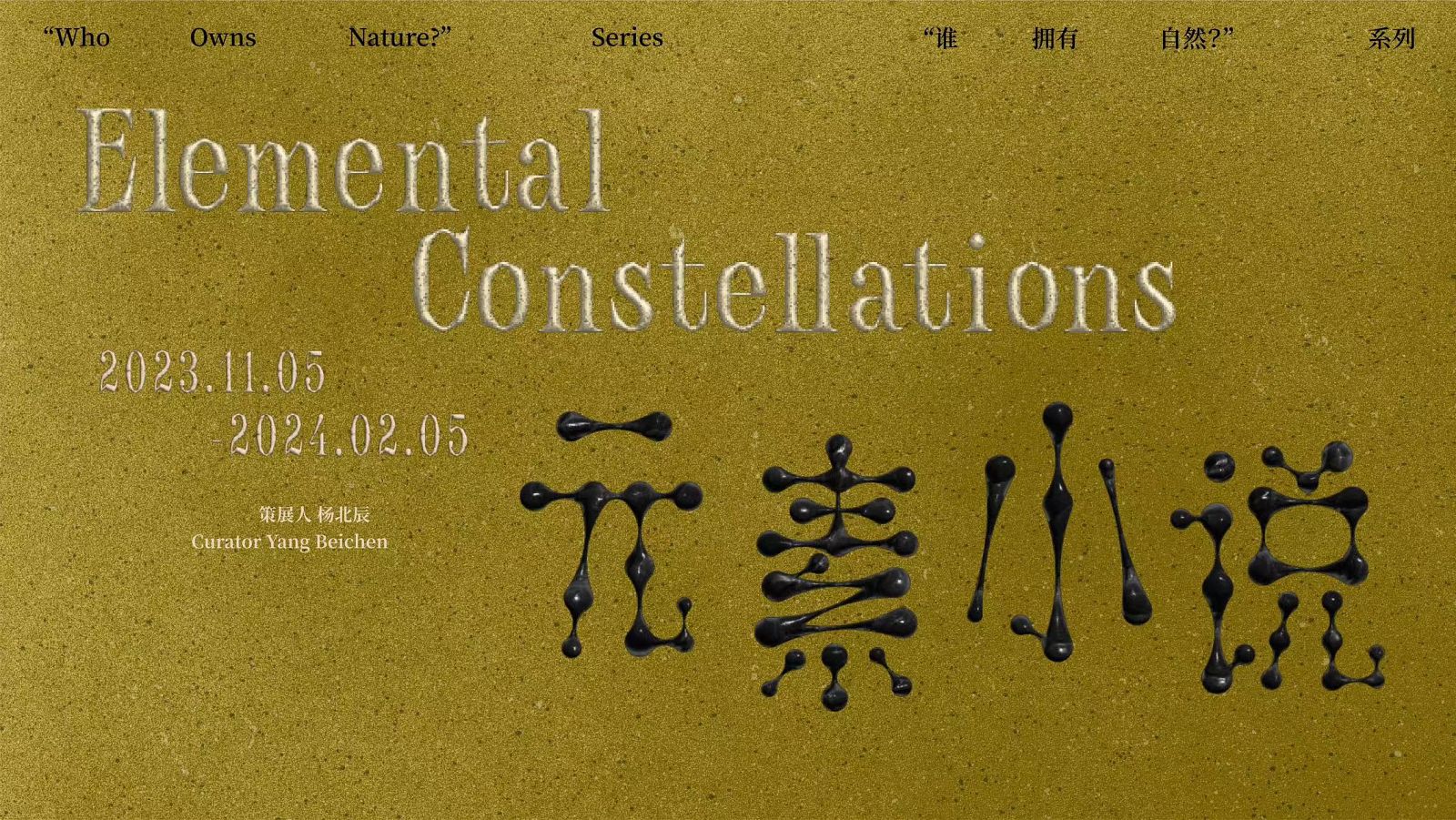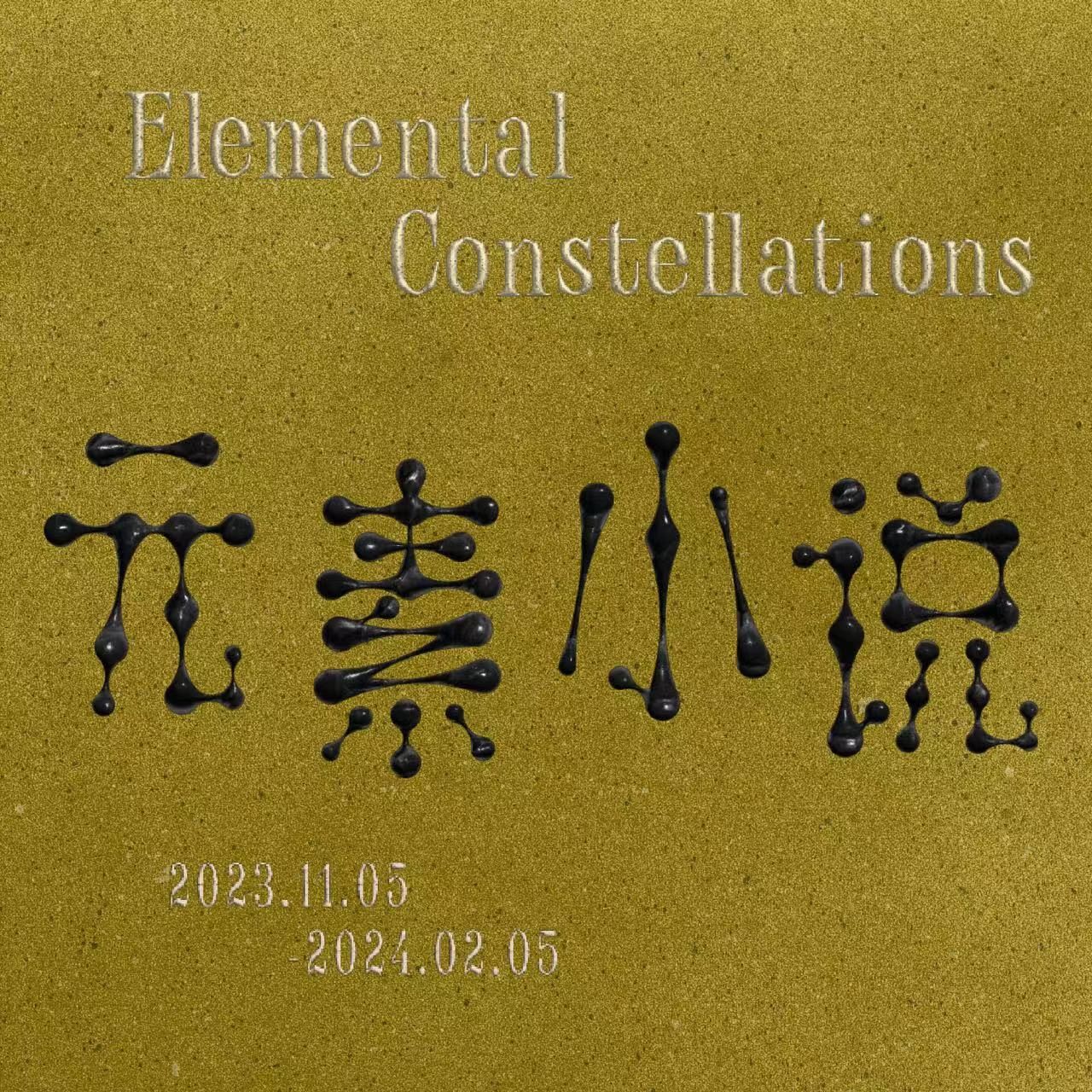 Elemental Constellations
Elemental Constellations
2023.11.28 Tuesday
This article is the curatorial note written by Yang Beichen, the curator of "Elemental Constellation".

01 The Fifth Element
In the movie The Fifth Element, the so-called “the fifth element” serves as a “MacGuffin”[1]: it remains unseen throughout the movie but becomes the focal point of every character's pursuit. It's also the central force propelling the narrative. This elusive element can be seen as a metaphor, suggesting that elements exist in an uncertain and undefinable form – invisible yet ubiquitous, possessing a mysterious and ineffably significant value. Obviously, “the fifth element” isn’t referring to a chemical element with a dense atomic nucleus surrounded by negatively charged electrons. Instead, it signifies a pre-modern configuration that does not fit within the periodic table.
By the end of the movie, the fifth element is revealed as “love,” leading to a quintessential Hollywood ending characterized by a typical tour-de-force elevation of artistic expression. That being said, we cannot categorically label such an expression as incorrect. The “real” fifth element has its actual name: Ether. As described by Empedocles, ether is the fundamental building block of the world, a composite of air and fire. It’s ever-changing, unfixed. Similar to a “medium”, ether is always associated with “mixing”, facilitating the transmission of matter and energy in luminous, airy settings. But the true motive power behind the movement of ether is generated by “love” and “strife,” the tension between which results in the balance and confrontation of all matters in the world. If love claims the predominant and central role in the movement, then all the mixtures gravitate toward convergence and even distribution; otherwise, things degenerate into disintegration and chaos. The eternal opposition of “love” and “strife” enables ether to maintain the essence of constant circulation and dynamics, enabling various entities to intertwine.
As the incarnation of “the fifth element,” the female protagonist of the movie embodies an ether-esque physicality. Her vitality is derived when the strengths of the two feelings are in tension or relative motion with each other. Regardless of how ridiculous this Hollywood interpretation of a pre-Socrates elemental cosmology may appear, it indeed successfully suggests that humans, with their physical beings, represent this fifth element in the present day. However, in our interactions with the world, we often lean towards strife over love. Humanity has grown into a formidable power capable of profoundly reshaping the land, ocean, and sky. In the Anthropocene era, we take aggressive actions toward nature as if we are completely isolated from it, neglecting the fact that ether resides within us too. Just as Stacy Alaimo has pointed out, “(element) is not something outside us that knowers capture or disclose but always the stuff that we ourselves are, the stuff that is lively and often unpredictable. Transcorporeal subjects find themselves at the confluence of body, substance, and place, never distinct from the fluctuating world they seek to know.”[2]
02 Writing a postscript for alchemy
In a way, chemical elements contrast with philosophical, cosmological, or mythological elements. These days, technology dominates the discourse of elements. However, what lies beneath is an intention to impose transmutation and social discipline upon non-human entities. Referencing Empedocles’ four element cosmology or the Chinese traditional five element theory wuxing, the classical “elemental thinking” stresses that elements represent the nature’s forces and the all matters’ state of being: water, fire, air, and earth continuously and dynamically intermingle with other substances, leaving their traces on the land, being eroded by tidal waves, melted by the sun, carried away by wind, or devoured by vegetation – in this way, they become “elements of perception,” leaving only faint remnants of their presence for human beings to capture.
The passion of ancient alchemists to transform elements remains a catalyst for the present-day speculative imagination. Their “alliance” with various elements inspires visions of “how to become others.” The resurgence of the “alchemy mind” stems from an ontological "temptation", that is, seeking an alternate cosmological model: in the case of cosmologies that are based on indigenous or alternative epistemologies, an element might be a simple spark, a patch of land, air breathed in, or water sipped; the existences of stone, light, cloud, wind and snow are a priori expressions of elemental ontology, while lying in a state of being that precedes but is also deeply intertwined with daily life. Therefore, nature transforms from a fixed realm of meaning to an “ontological repository” filled with possibilities, as well as a philosophical and ecological framework that is increasingly fluid, open-ended, and ductile.
This model of ontological pluralism interacts with multiple contemporary theories, especially New Materialism, which is based on a critical de-anthropocentric perspective. The most perplexing question in the studies of New Materialism is how to deal with the intermingling of substance and narrative, materiality and metaphor. We can't assert, as confidently as Empedocles once did, that elemental forces swing between “love” and “strife.” Nonetheless, it is exactly because we live in a drastically changing world that fictional epistemology of elements sees the chance to provide a certain “positive” impossibility, hence penetrating the material myth concocted by utilitarian science and greedy capitalism. Just as Jeffrey Jerome Cohen has stated, “even when our elemental stories are mired in anthropocentrism, their animating vectors are capable of inhuman transport, capable of provoking a vision of the world that does not simply reaffirm human primacy.”[3]
03 Autobiography and the Kitchen
“Carbon and oxygen me, gold, silver and metal me, even rare earth. The value of someone, that is to say his health, is measured by the number and quality of his valences.”[4]
“As chemical categories, as cosmological forces, as material things, as social forms, as forces and energies, as sacred entities, as experimental devices, as cultural tropes, as everyday stories, and as epistemic objects.”[5]
There is no doubt that the most intriguing aspect of Primo Levi’s autobiographical novel, The Periodic Table, is its framing of human life experiences within the format of a periodic table. Each element’s name hints at a specific life story, as if these inorganic substances possess a unique ability to write, thereby influencing the protagonist’s fate. Modern chemical elements, unlike their classical counterparts, are not bodily, cultural, or imaginary entities, and don't naturally exude the “subtle but frolic” light, nor do they spontaneously inspire or reshape the world in unpredictable ways. Often, they represent a boundary, an impenetrable material curtain, or even an explicit violence. Yet, Levi ingeniously blurs these boundaries, removes the curtain and violence, endowing elements with literary representations and sensory values, infusing them with captivating volatility and uncertainty.
It seems to indirectly prove that, by combining chemistry with cosmology, we can stimulate the potential of elements, and that merging these disciplines can resurrect the essence of alchemy and counter the trend of commodifying elements. Suppose a kind of “Elemental Ecology.” When the realms of chemical industry and alchemy merge, or when the gap between nature and the artificial is bridged through the power of emotions and memories, a new “natural industry” emerges. Consequently, those synthesized chemical matters can likewise stir up earth, air, water and fire, giving rise to an alternative technology with totally unique process, impact and intensity. In other words, within the highly stable periodic table, lies the chance to counteract the pitfalls of late-stage capitalism. In Andrei Tarkovsky’s film Stalker, the characters enter a “Zone” contaminated by chemicals. Despite the life-threatening dangers, the director does not interpret the “Zone” as a metaphor or reference to anything. Rather, this perilous ecological feature nourishes a certain “aesthetic feeling.” Tarkovsky grants certain elements, like water, a remarkable “membrane-like” texture, turning a hazardous ecological feature into an aesthetic experience. Living in the Anthropocene world severely polluted by chemicals, perhaps our challenge is nothing else but how to preserve the divine and aesthetical cultural potential for elements under the current situation. We might need to reinvent an “elemental poetics,” an action concerning “the becoming chemical of life and the ecological becoming of chemical practice”[6] in scholar Dimitris Papadopoulos’ words.
(I envision an ideal state of being: Imagine a universe akin to a kitchen, with a nature-shaman energy as the chef. She experiments with recipes that transcend the boundary between life and non-life, and looking for elements that can be used as “ingredients” on a planetary scale – cultural or chemical. She creates different “dishes” by making use of their material affinity. “Cosmic cooking” relies on the chemical processes of the elements themselves, such as decomposition, composition, decay, and corrosion, so that we can further imagine another process of “composting” – the waste from this kitchen and the decayed food residues can be synthesized into a mild byproduct and return to the earth through the biotic decomposition of bacteria.)
04 New Extractivism
However, we cannot overlook the inherent shadow within elemental ecology, notably the pervasive New Extractivism[7]. Petro-chemical capitalism drives global-scale production, which involves all human beings while denying them equal access to these elements. This constitutes a form of violence, a violence that is engendered by the modes of production and consumption stemming from the unusual relationship between nature, colonial conquest, industrial revolution, and capitalism. Minerals and fossil fuels continue to be extracted from deep down the earth and brought to the present from a distant geological time. The long history innate to the existences of these elements is rapidly exhausted within a few hundreds of Anthropocene years. Kate Crawford's research elucidates the nexus between contemporary technologies and elements: “the cloud is the backbone of the artificial intelligence industry, and it’s made of rocks and lithium brine and crude oil… Each object in the extended network of an AI system, from network routers to batteries to data centers, is built using elements that required billions of years to form inside the earth.”[8] It is important to understand these contrasting temporalities: the elements originally corresponded to the long evolutionary history of the planet, but they have since been extracted and transformed into new synthesized compound materials (e.g. plastic) which now cover the entire earth. In an extremely short period of time, they have formed a new state of geological ontology (Geotologies), and are destined to co-exist with us for a very long time in future in other forms (e.g. electronic waste.)
Moreover, the New Extractivism, in tandem with neoliberalism, establishes the “One-World World” paradigm, proliferating its ontological dominion across global territories. This occupation is initiated by the “One-World World” – a capitalistic, patriarchal, white, and modern world, which John Law accurately encapsulated as “a world that has granted itself the right to assimilate all other worlds and, by presenting itself as exclusive, cancels possibilities for what lies beyond its limits.”[9] This world, self-claiming as the one and only, refuses to engage with the other worlds. Then, New Extractivism bolsters this “One-World World” expansion and seizes a massive amount of “terra nullius” for it, rendering the other worlds with real loci disappeared or absent. In Latin America and Africa, we have witnessed how multinational corporations parasitize the rich land, craving its blood like vampires, exploiting resources in unreasonably cheap prices, all while remaining indifferent to local suffering.
How do we combat the colonialization propelled by New Extractivism, both spatially and temporally? Perhaps we can reconceptualize elements as “ghosts.” During global anti-extractivism and anti-colonialism movements, certain non-western indigenous communities regard minerals or other element materials as a form of life and develop a partnership with them. This strategy implies that by becoming a ghost– an uncertain, ever-present specter seeking alliances, can one evade the fate of extraction. Their alliance with elements symbolizes an alternative, non-capitalistic, non-national, and just guerrilla force, where the boundary between life and non-life evolves into specific tactics of resistance.
“Here the elements reactivate us as practitioners of alterlife, as co-conspirators with the elements in efforts to resist harm and violence, while attempting to transform earthly processes of living and dying.”[10]
[1] MacGuffin is an object, event, or character in a film or story that serves to set and keep the plot in motion despite usually lacking intrinsic importance.
[2] Stacy Alaimo, Elemental Love in the Anthropocene.
[3] Jeffrey Jerome Cohen, The Sea Above.
[4] MICHEL SERRES, Biogea.
[5] Dimitris Papadopoulos, María Puig de la Bellacasa, and Natasha Myers, From cosmology to episteme and back.
[6] Dimitris Papadopoulos, Chemicals, ecology, and reparative justice.
[7] Under the neoliberal world order, New Extractivism, which refers to the exploitation and export of the mineral and energy commodities in their raw state, is viewed as promising development strategies.
[8] Kate Crawford, Atlas of AI: Power, Politics, and the Planetary Costs of Artificial Intelligence.
[9] John Law, What's wrong with a one-world world?
[10] Dimitris Papadopoulos, María Puig de la Bellacasa, and Natasha Myers, From cosmology to episteme and back.
Yang Beichen
Dr. Yang Beichen is a researcher and a curator based in Beijing, China. He is the director of the MACA(Beijing), and one of the members of the Thought Council at the Fondazione Prada (Milan, Venice).Currently teaching at the Central Academy of Drama, his research examines the agency and potentialities of the moving image in the context of contemporary technology and ecology, deploys media archaeology as a radical framework to excavate alternative modernities, and ultimately aims to re-interpretate history and geopolitics from a New Materialist standpoint. His curatorial practices grow out of and attest to his multidisciplinary academic approaches. Notable curatorial projects include “New Metallurgists” (Julia Stoschek Collection, Düsseldorf), “Micro-Era” (Kulturforum, Berlin), the Guangzhou Image Triennial 2021 "The Intermingling Flux" (Guangdong Museum of Art, Guangzhou), “A MOON WRAPPED IN BROWN PAPER” (Prada Rong Zhai, Shanghai) , etc. Between 2019 and 2021, he also led a three-year research project focusing on the art of moving image in China at the NCAF, for which he curated three research-based exhibitions: “Anti-Projection: Media Sculptures in Early Chinese Video Art”, “Embodied Mirror: Performances in Chinese Video Art”, and “Polyphonic Strategies: The Moving Image and its Expanded Field”. He has also contributed critical essays for the catalogues of the artists such as Cao Fei, Laure Prouvost, Omer Fast and HO Tzu Nyen, etc. His academic monograph “Film as Archive” will be published soon.
